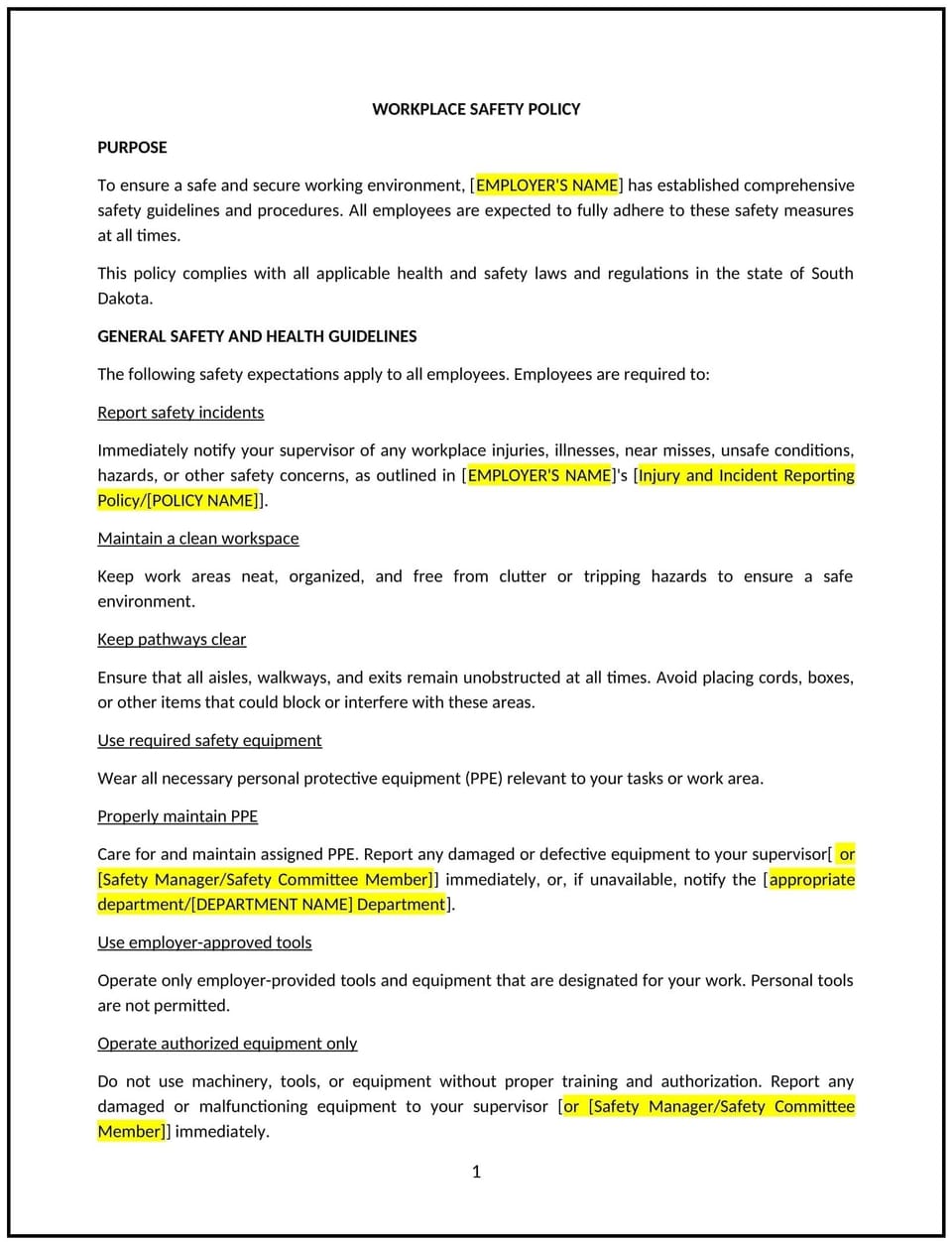Workplace safety policy (South Dakota): Free template

Workplace safety policy (South Dakota)
This workplace safety policy is designed to help South Dakota businesses establish guidelines for maintaining a safe and healthy work environment. It outlines procedures for identifying hazards, preventing accidents, and responding to emergencies.
By adopting this policy, businesses can reduce risks, ensure compliance with safety regulations, and align with general best practices for workplace safety.
How to use this workplace safety policy (South Dakota)
- Identify hazards: Conduct regular risk assessments to identify potential hazards in the workplace.
- Implement safety measures: Provide guidelines for preventing accidents, such as proper equipment use, signage, and safety training.
- Establish emergency procedures: Outline steps for responding to emergencies, such as fires, medical incidents, or natural disasters.
- Provide safety training: Educate employees on safety protocols, hazard recognition, and emergency response.
- Monitor compliance: Regularly review workplace conditions and employee adherence to safety procedures.
- Address incidents: Investigate accidents or near-misses and take corrective action to prevent future occurrences.
- Review and update: Assess the policy annually to ensure it aligns with evolving workplace needs and safety regulations.
Benefits of using this workplace safety policy (South Dakota)
This policy offers several advantages for South Dakota businesses:
- Promotes a safe workplace: Establishes clear guidelines for preventing accidents and ensuring employee well-being.
- Reduces risks: Helps mitigate the likelihood of workplace incidents and associated legal or financial liabilities.
- Aligns with legal standards: Ensures compliance with state and federal safety regulations, such as OSHA requirements.
- Enhances employee confidence: Shows employees that the business prioritizes their safety and well-being.
- Improves productivity: A safe work environment reduces downtime caused by accidents or injuries.
Tips for using this workplace safety policy (South Dakota)
- Communicate the policy: Share the policy with employees and include it in the employee handbook.
- Provide training: Educate employees and managers on safety protocols, hazard recognition, and emergency response.
- Monitor compliance: Regularly review workplace conditions and employee adherence to safety procedures.
- Address issues promptly: Take immediate action to correct safety hazards or violations.
- Update regularly: Review the policy annually to ensure it remains relevant and effective.
Q: How does this policy benefit businesses?
A: It promotes a safe workplace, reduces risks, and aligns with legal standards for workplace safety.
Q: What types of hazards should businesses address?
A: Hazards may include unsafe equipment, slippery floors, fire risks, or exposure to harmful substances.
Q: How should businesses handle workplace accidents?
A: Businesses should investigate accidents promptly, provide medical attention if needed, and take corrective action to prevent future incidents.
Q: Are businesses required to provide safety training?
A: Yes, businesses are generally required to provide safety training to employees under state and federal regulations.
Q: How often should businesses review this policy?
A: Businesses should review the policy annually or as needed to ensure it aligns with evolving workplace needs and safety regulations.
This article contains general legal information and does not contain legal advice. Cobrief is not a law firm or a substitute for an attorney or law firm. The law is complex and changes often. For legal advice, please ask a lawyer.


